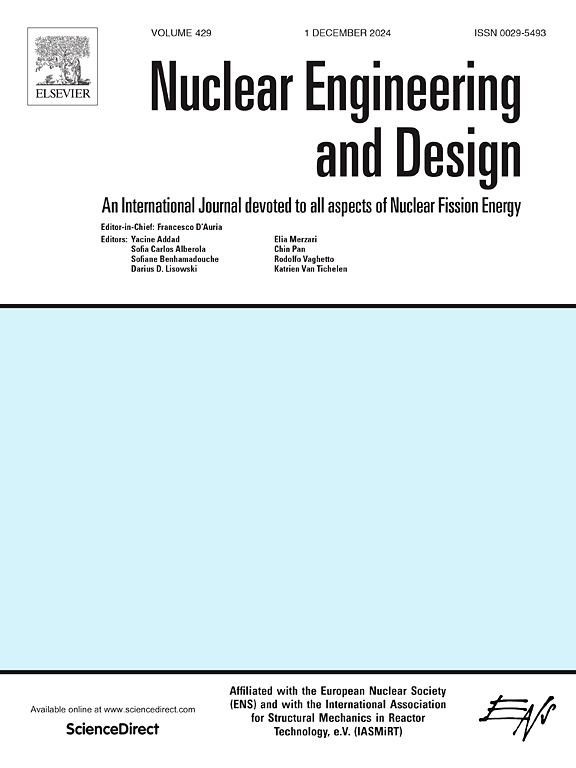Numerical investigation on the irradiation-induced mechanics behavior in U3Si2/Al dispersion fuel using RVE model
IF 2.1
3区 工程技术
Q1 NUCLEAR SCIENCE & TECHNOLOGY
引用次数: 0
Abstract
A representative volume element (RVE) model was developed to investigate the thermo-mechanical behavior of U3Si2/Al dispersion fuel under irradiation. The study focused on the evolution of thermal expansion, elastic properties, creep, and irradiation-induced swelling across varying irradiation conditions. RVE models with different uranium densities were constructed using Voronoi tessellation to approximate the irregular geometry of fuel particles. A phase-field approach was employed to simulate the growth of the interaction layer. Coupled with the finite element method (FEM), a series of detailed simulations were conducted. The simulations revealed that increasing interaction layer thickness (from 0 μm to 20 μm) significantly reduces the thermal expansion coefficient by up to 28 % while increasing stiffness. Higher fission density and fuel particle volume fraction lead to greater swelling strain. The effect of interaction layer thickness on equivalent swelling strain exhibits a dual behavior. The creep behavior is affected by both the interaction layer volume fraction and the applied stress, and can be effectively described by a polynomial-based constitutive model. Compared to traditional homogenization methods, the RVE approach offers improved accuracy in capturing the effects of microstructural heterogeneity on macroscopic fuel performance. These results demonstrate the model applicability for evaluating and optimizing dispersion fuel behavior under irradiation.
基于RVE模型的U3Si2/Al弥散燃料辐照力学行为数值研究
建立了具有代表性的体积元(RVE)模型,研究了U3Si2/Al分散燃料在辐照下的热力学行为。研究的重点是在不同的辐照条件下热膨胀、弹性、蠕变和辐照引起的膨胀的演变。利用Voronoi镶嵌法建立了不同铀密度的RVE模型,以近似燃料颗粒的不规则几何形状。采用相场法模拟了相互作用层的生长过程。结合有限元法,进行了一系列详细的数值模拟。模拟结果表明,增加相互作用层厚度(从0 μm增加到20 μm)可显著降低热膨胀系数达28%,同时增加刚度。较高的裂变密度和燃料颗粒体积分数导致较大的膨胀应变。相互作用层厚度对等效膨胀应变的影响表现为双重特性。蠕变行为受相互作用层体积分数和外加应力的影响,可以用基于多项式的本构模型有效地描述。与传统的均质化方法相比,RVE方法在捕获微观结构非均质性对宏观燃料性能的影响方面具有更高的准确性。结果表明,该模型可用于评价和优化分散燃料在辐照下的性能。
本文章由计算机程序翻译,如有差异,请以英文原文为准。
求助全文
约1分钟内获得全文
求助全文
来源期刊

Nuclear Engineering and Design
工程技术-核科学技术
CiteScore
3.40
自引率
11.80%
发文量
377
审稿时长
5 months
期刊介绍:
Nuclear Engineering and Design covers the wide range of disciplines involved in the engineering, design, safety and construction of nuclear fission reactors. The Editors welcome papers both on applied and innovative aspects and developments in nuclear science and technology.
Fundamentals of Reactor Design include:
• Thermal-Hydraulics and Core Physics
• Safety Analysis, Risk Assessment (PSA)
• Structural and Mechanical Engineering
• Materials Science
• Fuel Behavior and Design
• Structural Plant Design
• Engineering of Reactor Components
• Experiments
Aspects beyond fundamentals of Reactor Design covered:
• Accident Mitigation Measures
• Reactor Control Systems
• Licensing Issues
• Safeguard Engineering
• Economy of Plants
• Reprocessing / Waste Disposal
• Applications of Nuclear Energy
• Maintenance
• Decommissioning
Papers on new reactor ideas and developments (Generation IV reactors) such as inherently safe modular HTRs, High Performance LWRs/HWRs and LMFBs/GFR will be considered; Actinide Burners, Accelerator Driven Systems, Energy Amplifiers and other special designs of power and research reactors and their applications are also encouraged.
 求助内容:
求助内容: 应助结果提醒方式:
应助结果提醒方式:


